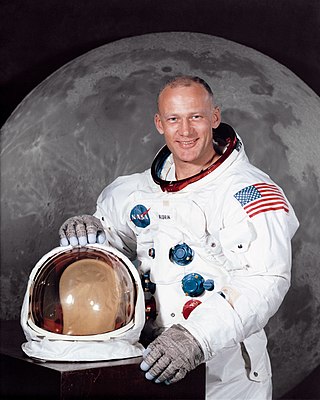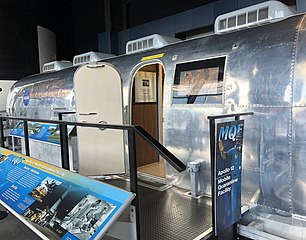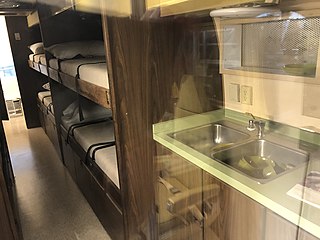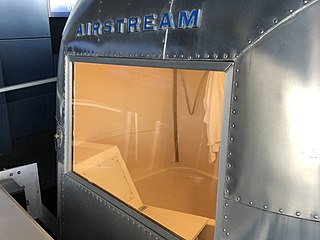
Apollo 11 was the American spaceflight that first landed humans on the Moon. Commander Neil Armstrong and lunar module pilot Buzz Aldrin landed the Apollo Lunar Module Eagle on July 20, 1969, at 20:17 UTC, and Armstrong became the first person to step onto the Moon's surface six hours and 39 minutes later, on July 21 at 02:56 UTC. Aldrin joined him 19 minutes later, and they spent about two and a quarter hours together exploring the site they had named Tranquility Base upon landing. Armstrong and Aldrin collected 47.5 pounds (21.5 kg) of lunar material to bring back to Earth as pilot Michael Collins flew the Command Module Columbia in lunar orbit, and were on the Moon's surface for 21 hours, 36 minutes before lifting off to rejoin Columbia.

Apollo 13 was the seventh crewed mission in the Apollo space program and the third meant to land on the Moon. The craft was launched from Kennedy Space Center on April 11, 1970, but the lunar landing was aborted after an oxygen tank in the service module (SM) failed two days into the mission. The crew instead looped around the Moon and returned safely to Earth on April 17. The mission was commanded by Jim Lovell, with Jack Swigert as command module (CM) pilot and Fred Haise as Lunar Module (LM) pilot. Swigert was a late replacement for Ken Mattingly, who was grounded after exposure to rubella.

Apollo 10 was a human spaceflight, the fourth crewed mission in the United States Apollo program, and the second to orbit the Moon. NASA described it as a "dress rehearsal" for the first Moon landing, and designated it an "F" mission, intended to test all spacecraft components and procedures short of actual descent and landing. While astronaut John Young remained in the Command and Service Module (CSM) orbiting the Moon, astronauts Thomas Stafford and Gene Cernan flew the Apollo Lunar Module (LM) to within 15.6 kilometers (8.4 nmi) of the lunar surface, the point at which powered descent for landing would begin on a landing mission, before rejoining Young in the CSM. After orbiting the Moon 31 times, Apollo 10 returned safely to Earth; its success enabled the first crewed landing during Apollo 11 two months later.

Apollo 12 was the sixth crewed flight in the United States Apollo program and the second to land on the Moon. It was launched on November 14, 1969, by NASA from the Kennedy Space Center, Florida. Commander Charles "Pete" Conrad and Lunar Module Pilot Alan L. Bean performed just over one day and seven hours of lunar surface activity while Command Module Pilot Richard F. Gordon remained in lunar orbit.

Apollo 14 was the eighth crewed mission in the United States Apollo program, the third to land on the Moon, and the first to land in the lunar highlands. It was the last of the "H missions", landings at specific sites of scientific interest on the Moon for two-day stays with two lunar extravehicular activities.

Apollo 17 was the final mission of NASA's Apollo program, the most recent time humans have set foot on the Moon or traveled beyond low Earth orbit. Commander Gene Cernan and Lunar Module Pilot Harrison Schmitt walked on the Moon, while Command Module Pilot Ronald Evans orbited above. Schmitt was the only professional geologist to land on the Moon; he was selected in place of Joe Engle, as NASA had been under pressure to send a scientist to the Moon. The mission's heavy emphasis on science meant the inclusion of a number of new experiments, including a biological experiment containing five mice that was carried in the command module.

Buzz Aldrin is an American former astronaut, engineer and fighter pilot. He made three spacewalks as pilot of the 1966 Gemini 12 mission. As the Lunar Module Eagle pilot on the 1969 Apollo 11 mission, he and mission commander Neil Armstrong were the first two people to land on the Moon.

William Alison Anders is a retired United States Air Force (USAF) major general, former electrical engineer, nuclear engineer, NASA astronaut, and businessman. In December 1968, he was a member of the crew of Apollo 8, the first three people to leave low Earth orbit and travel to the Moon. Along with fellow astronauts Frank Borman and Jim Lovell, Anders circled the Moon ten times, and broadcast live images and commentary back to Earth. During one of the mission's lunar orbits, he took the iconic Earthrise photograph.

Splashdown is the method of landing a spacecraft by parachute in a body of water. It was used by crewed American space capsules prior to the Space Shuttle program, by SpaceX Dragon and Dragon 2 capsules and by NASA's Orion Multipurpose Crew Vehicle. It is also possible for the Russian Soyuz spacecraft to land in water, though this is only a contingency. The only example of an unintentional crewed splashdown in Soviet history is the Soyuz 23 landing.

Michael Collins was an American astronaut who flew the Apollo 11 command module Columbia around the Moon in 1969 while his crewmates, Neil Armstrong and Buzz Aldrin, made the first crewed landing on the surface. He was also a test pilot and major general in the U.S. Air Force Reserve.

Charles Moss Duke Jr. is an American former astronaut, United States Air Force (USAF) officer and test pilot. As Lunar Module pilot of Apollo 16 in 1972, he became the tenth and youngest person to walk on the Moon, at age 36 years and 201 days.

Clifton Curtis Williams Jr., was an American naval aviator, test pilot, mechanical engineer, major in the United States Marine Corps, and NASA astronaut, who was killed in a plane crash; he never went into space. The crash was caused by a mechanical failure in a NASA T-38 jet trainer, which he was piloting to visit his parents in Mobile, Alabama. The failure caused the flight controls to stop responding, and although he activated the ejection seat, it did not save him. He was the fourth astronaut from NASA's Astronaut Group 3 to have died, the first two having been killed in separate T-38 flights, and the third in the Apollo 1 fire earlier that year. The aircraft crashed in Florida near Tallahassee within an hour of departing Patrick AFB.

Ronald Ellwin Evans Jr. was an American electrical engineer, aeronautical engineer, officer and aviator in the United States Navy, and NASA astronaut. As Command Module Pilot on Apollo 17 he was one of the 24 astronauts to have flown to the Moon, and one of 12 people to have flown to the Moon without landing on it.

The Lunar Receiving Laboratory (LRL) was a facility at NASA's Lyndon B. Johnson Space Center that was constructed to quarantine astronauts and material brought back from the Moon during the Apollo program to reduce the risk of back-contamination. After recovery at sea, crews from Apollo 11, Apollo 12, and Apollo 14 walked from their helicopter to the Mobile Quarantine Facility on the deck of an aircraft carrier and were brought to the LRL for quarantine. Samples of rock and regolith that the astronauts collected and brought back were flown directly to the LRL and initially analyzed in glovebox vacuum chambers.

Space Center Houston is a science museum that serves as the official visitor center of NASA Johnson Space Center in Houston. It was designated a Smithsonian Affiliate museum in 2014. The organization is owned by NASA, and operated under a contract by the nonprofit Manned Spaceflight Education Foundation, a 501(c)(3) organization. The Johnson Space Center is the home of Mission Control and astronaut training.

The USS Hornet Museum is a museum ship, located on the southernmost pier of the former Naval Air Station Alameda in Alameda, California, US.
William Carpentier is a Canadian-American physician best known as the flight surgeon assigned to the United States' Apollo 11 mission, the first manned spacecraft to land on the Moon. Carpentier says that this was the highlight of his career. In the months following the Apollo 11 mission, Carpentier became known as a world famous physician. He later went into nuclear medicine research.

John Hirasaki is an American mechanical engineer who worked for the United States' National Aeronautics and Space Administration (NASA) during the Apollo 11 mission, the first crewed mission to the Moon. In 1969 he – along with Buzz Aldrin, Neil Armstrong, Michael Collins, and William Carpentier – became one of the first five known humans to view lunar rocks inside Earth's atmosphere.

Helicopter 66 is a United States Navy Sikorsky Sea King helicopter used during the late 1960s for the water recovery of astronauts during five missions of the Apollo program. It has been called "one of the most famous, or at least most iconic, helicopters in history", was the subject of a 1969 song by Manuela, and was made into a die-cast model by Dinky Toys. In addition to its work in support of NASA, Helicopter 66 also transported the Shah of Iran during his 1973 visit to the aircraft carrier USS Kitty Hawk.

Apollo 11 was the first human spaceflight to land on the Moon. In the decades after its 1969 mission took place, widespread celebrations have been held to celebrate its anniversaries.






























